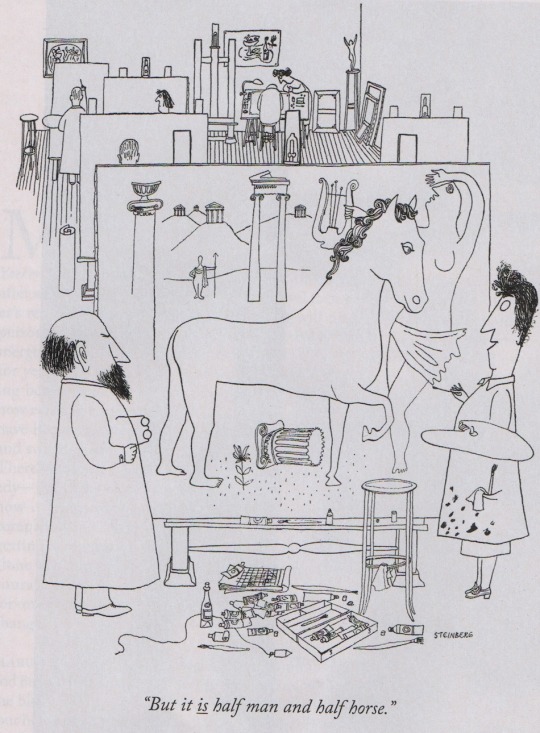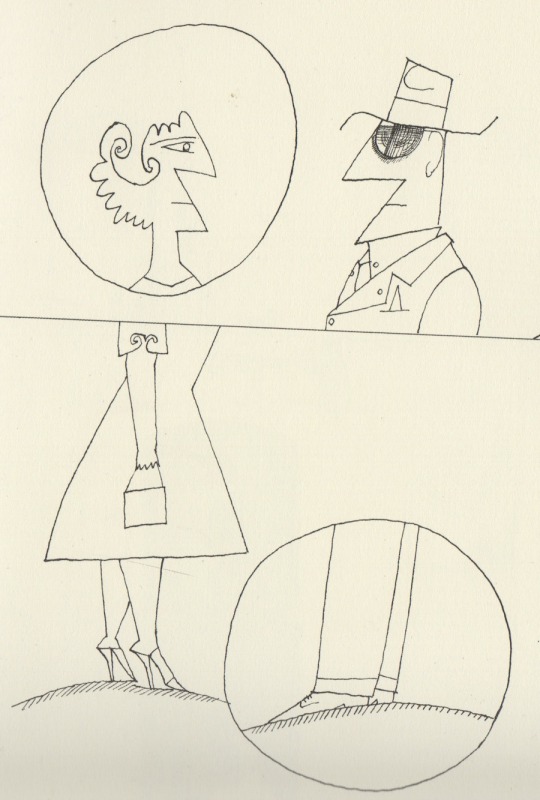#i saw the original poster and it was so sick i had to redraw it
Explore tagged Tumblr posts
Text

why don’t they make posters like this anymore
#i saw the original poster and it was so sick i had to redraw it#sonic the hedgehog#shadow the hedgehog#sonic#my art
34K notes
·
View notes
Text
A Year Of Reading Acknowledged Masterpieces #2: Saul Steinberg’s The Labyrinth
Maybe my most pointless worry is for how aliens, or whatever civilization comes after us, will struggle to learn anything from the jumble of signals that is this modern moment of our undoing. Our language and its referents cannot be understood without full immersion, and so much of what holds a privileged place in our culture, like religion or celebrity, correlates to daily existence in a confused and unclear manner. I dwell on this theoretical future because my far more pressing worries make art feel useless and decadent. As much as I love work that feels like it’s arrived as an artifact from a parallel universe, like Peter Greenaway’s The Falls or Ben Marcus’s Notable American Women, they only confuse the issue of an easily imagined not-too-distant future where everything recognizable is extinct, and even man’s many gestures at mimetic realism and journalistic explanations appear to the only prevailing consciousness as incomprehensible as the Codex Seraphinus.
It is in the context of this insane existential anxiety that Saul Steinberg’s work functions as a huge relief. Here the big ideas and our idle habits are captured in the same graceful line. It’s beautiful and funny, thoughtfully considered but never belabored. Everything feels like the platonic ideal of ideas being captured in a distilled form; if I were to liken it to music I would cite John Fahey. Fahey had a hit record with a Christmas LP, Steinberg’s work achieved a high circulation due to its placement in The New Yorker. The cartoons in that magazine seem vaguely notorious for being unfunny and inscrutable, at least to a generation that remembers vividly that one Seinfeld episode and was otherwise weaned on the gags in The Far Side. There are people who dismiss Christmas music as a concept as well. While Steinberg’s work definitely lives up to any rep for dry wit, I don’t really view any of it as being gags. Once you remove the expectation that this work is intended to elicit a laugh it becomes pretty easy to see it as just great art, and its placement in a widely-circulated magazine is just a better delivery system to the masses than art galleries are.

Here’s a Steinberg cartoon the New Yorker reprinted a few months back. It’s from a different time period than the stuff in The Labyrinth. It contains a caption, which none of the pieces in The Labyrinth do, though whether or not they did on their first publication is unknown to me.
The Labyrinth is an art book somewhere between a monograph and a sketchbook, edited and ordered for maximum readability as sets of ideas are explored. Many of those ideas are about drawing, and the drawing often feels close to doodling, as many pieces explore what you can do with a single line without removing pen from paper. It is arguably “not comics,” in that there isn’t a story you read from panel to panel, but the relationship to comics is pretty clear. If you are a maker of “avant-garde” or “art” comics, this book would be as informative to your process as reading E.C. Segar’s Popeye* would be for someone who writes Iron Man. Originally published in 1960, it was recently reprinted by NYRB, although not through their comics imprint, which has published artists whose work is prefigured here. Certain drawings seem to outline ideas that would be elaborated on in Pushwagner’s Soft City (drawn in the seventies, and published by NYRB a few years back), and drawings of people playing music, where the sound is rendered as various abstractions, bring to mind stuff in Blutch’s Total Jazz, published by Fantagraphics in 2018, though NYRB handled an English-language version of his book Peplum in 2016. There’s also stuff in the drawing that calls to mind Sasaki Maki’s Ding Dong Circus. All of these works are done by people outside of the U.S., and I can’t really assert with any historical certainty that those people saw the work in question before their own undertakings, though the amount of copies of The New Yorker that are printed make it seem not impossible. It also seems like Steinberg might’ve attained something of a celebrity status enough that potentially photographs of his drawings of women on bathtubs would’ve made it to Life magazine or something. As great as the drawing is, I’m not sure how much of it you would deliberately copy unless you were seeing individual images in isolation. Seeing so much collected in one place the takeaway is how unaffected it all is: It might inspire you to do more sketchbook drawing to see if you can capture the energy of life as effectively as Steinberg did, but you’re certainly not going to capture the verve of his line by studiously redrawing his work.
In terms of intent, Steinberg’s cartoons set a precedent for Jules Feiffer’s Explainers strips, which would run in The Village Voice a few years later. Feiffer, of course, was well-versed in various kinds of comics, having worked in Eisner’s studio, and his avid readership of the earliest comic books is documented in his book The Great Comic-Book Heroes, but there’s not really anything in that stuff suggestive of the sort of observational acuity of the middle-class that you get in his writing, that is present in Steinberg’s work. The depictions of playing music are rendered similarly his depicting to other forms of communication as outgrowth of power dynamics. The drawings of art galleries and artist’s studios exist alongside pieces that seem to primarily document his own drawing process, all of it capturing how much of mankind’s energy is spent choosing to willfully distract itself, how much we throw ourselves into art. In Feiffer you read these self-involved and circular monologues and dialogues of educated neurotics. Steinberg depicts what these people get up to when they’re not talking through their thoughts, but the reader can still intuit the neuroses through posture and gesture, and the depiction of the social settings that create them.

This is done largely without language. If on first publication they were accompanied by typeset lines of dialogue beneath them, those have been excised for posterity. When a selection of drawings of Russia appear, you recognize it by changes in architecture and fashion. Towards the end, however, there are a few pieces that use lettering as part of the landscape of a piece to convey the meaning of the word being used, i.e. a piece where the word “sick” is laid up in bed. The afterword, dating from the time of the first printing, calls these drawings “conceptual art,” a term which would soon after be applied to something else entirely, making this attempt at nomenclature the sort of historical footnote that’s funny to me. These pieces aren’t the best stuff in the work. They have this children’s book illustration quality that nonetheless brings home how beyond language the rest of the book is. It’s a lesson in expression being taught by someone impossibly fluent, a genius condescending to explain himself: I probably would not have come up with this piece’s introductory paragraph, explaining a way into the work, without their precedent. After readers have been shown what humans are, they’re bestowed tools to understand language. These pieces appear at the end because they’re a way out of the labyrinth, out of Steinberg’s system of association between drawings where lines go wild, and back into the world of humdrum communication.
I have read speculation that music’s initial evolutionary purpose involved soothing the young. A mother’s lullaby, like a cat’s purring, is its origin, and both language and instrumental ornamentation followed later. The musicality of Steinberg’s line, as presented here, follows a similar arc, where beginning from a baseline of recognition at shared humanity, and advancing through harmonic extemporizing with each new suite of drawings serving as a piece of counterpoint, becomes both more abstract and more articulate. The end result is something like an ethnography and something like a symphony.

(*: I’m probably going to talk about Popeye next month. At least one motivating factor behind this series is to get away from the promotional cycle of hype for the new, and look at work worth of being approached almost like items on a syllabus. I hope it doesn’t result in too much writing where I list influenced works to make a case for “historical importance.”)
14 notes
·
View notes
Text
It's so hot

why don’t they make posters like this anymore
#i saw the original poster and it was so sick i had to redraw it#sonic the hedgehog#sonic#shadow the hedgehog#my art
34K notes
·
View notes